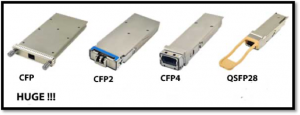Why is the 100G QSFP28 transceiver the best choice for 100G networks?
This past year has seen a remarkable growth in 100G deployments fueled primarily by hyperscale datacenters and cloud services. IHS Infonetics reports that by 2019, 100-gigabit-per-second (100G) Ethernet will make up more than 50 percent of data center optical transceiver transmissions.
The different 100G form factors
When 100G Ethenet standards were approved, the CFP was the first 100G module in the market. It was designed after the existing Small Form Factor (SFP) pluggable interface, but was significantly larger. The early CFP supported 10 x10 Gbps interconnects.
Improvements in technology allowed the development of CFP2 and CFP4 form factors. They are half and one quarter the size of the CFP respectively and have a higher port density than the CFP. Even though the power consumption came down from 25W (CFP) to 6W (CFP4), it was still considerably higher than 10G SFP+ and 40G QSFP+ transceivers.

What is the big deal with QSFP28?
The QSFP28 form factor emerged as a viable alternative to the power sapping CFP.
As the smallest form factor 100G, QSFP28 has the exact same footprint as the 40G QSFP+, thus making it considerably smaller than the CFP. The “Q” stands for quad. Offering 4 channels of high speed differential signals, QSFP28 implements up to 4 28Gbps/ lane.
QSFP28 transceivers use “Vertical Cavity Surface Emitting Lasers” or VCSELs for shorter distances of up to 200m. Longer distances of 2km to 40km use either DMLs or EMLs.
The QSFP28 emerged to fill the void for the datacenter customer whose primary considerations were port density, power consumption and cost. Let us talk about the benefits in more detail.
High Port Density Compared to CFP and the next generation CFP2 and CFP4, the QSFP28 is smaller in size making a great choice for Ethernet switch vendors who want to maximize the port density on their equipment. A 1RU slot will accommodate 36 100G QSFP28 ports but only 4 CFP ports.
Versatility The same QSFP28 port supports both cables as well as transceivers. In the first generation of 100G switches and routers, the smaller CXP form factor was used for cabling and the CFP or CFP2 was used for transceivers. This forced the equipment designer to make huge sacrifices. A switch with CXP ports could not be used in any data center with single mode fiber. With the QSFP28 port, transceivers, Direct Attach Cables (DACs) or Active Optical Cables (AOCs) can all plug into the same port.
Power Consumption While the CFP power consumption is around 25W, the QSFP28 consumes a measly 3.5 W. This may well be the single most important factor for a Datacom customer.
| FORM FACTOR | CFP | CFP2 | CFP4 | QSFP28 |
| DIMENSIONS (wxhxd) mm | 82 x 14 x 145 | 42 x 13 x 104 | 22 x 10 x 92 | 18 x 8.5 x 52 |
| POWER CONSUMPTION | < 25 W | < 12W | < 6W | < 3.5W |
Cost The higher port density and lower power consumption offer overall systems savings for the customer. Also the QSFP28 is significantly less expensive than the CFP.
The QSFP28 has become the most popular 100G form factor for the datacenter customer. There are different types of QSFP28 modules like the SR4, LR4, PSM4, CWDM4 etc. each with different architectures. With its low power consumption and versatility, the QSFP28 will enable easy deployment in 100G networks.
Vitex offers a broad range of QSFP28 solutions from transceivers to Direct Attach Cables (DACs) and Active Optical Cables (AOCs). Contact info@vitextech.com for more information.
Related Products



